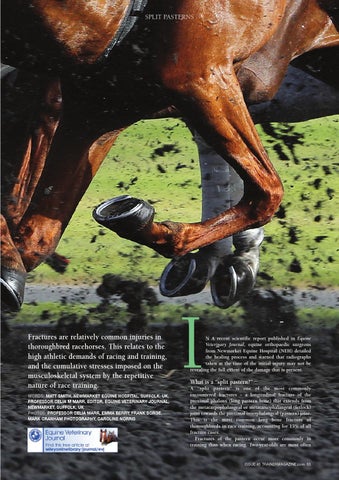EUROPEAN TRAINER ISSUE 45 SPLIT PASTERNS_Jerkins feature.qxd 28/03/2014 07:48 Page 2
SPLIT PASTERNS
Fractures are relatively common injuries in thoroughbred racehorses. This relates to the high athletic demands of racing and training, and the cumulative stresses imposed on the musculoskeletal system by the repetitive nature of race training. WORDS: Matt SMith, NeWMaRket equiNe hOSpital, SuffOlk, uk, pROfeSSOR Celia M MaRR, eDitOR, equiNe VeteRiNaRy JOuRNal, NeWMaRket, SuffOlk, uk phOtOS: pROfeSSOR Celia MaRR, eMMa BeRRy, fRaNk SORGe, MaRk CRaNhaM phOtOGRaphy, CaROliNe NORRiS
I
N A recent scientific report published in Equine Veterinary Journal, equine orthopaedic surgeons from Newmarket Equine Hospital (NEH) detailed the healing process and warned that radiographs taken at the time of the initial injury may not be revealing the full extent of the damage that is present.
What is a “split pastern?”
A “split pastern” is one of the most commonly encountered fractures – a longitudinal fracture of the proximal phalanx (long pastern bone) that extends from the metacarpophalangeal or metatarsophalangeal (fetlock) joint towards the proximal interphalangeal (pastern) joint. This is the most common long bone fracture of thoroughbreds in race training, accounting for 15% of all fracture cases. Fractures of the pastern occur more commonly in training than when racing. Two-year-olds are most often
ISSUE 45 TRAINERMAGAZINE.com 65
